The 3 Types of Value Investing
Which Type of Value Investor Are You?
In general, I consider there to be 3 broad types of value investing.
Now, value investing itself doesn't have a single definition since there are so many different schools of thought and methodologies practiced by those who seek to find value and attractive prices in the stock market.
But still, I find that there are three primary categories that emphasize a value-oriented approach to the stock market.
#1 - The Value Trader
I personally make a distinction between value investing and value trading.
In my mind, the value trader is someone who seeks to buy undervalued stocks and then hold them "until the market comes to its senses," at which time the shares are then sold and the process repeated.
Legendary investor John Neff, famous for his 31 year stint running Vanguard's Windsor Fund, is a classic example of this buy undervalued, sell fully valued approach.
Why do I call this value trading (and I don't intend that as a put down, by the way) rather than value investing?
Because the intent is never long term stock ownership. The objective is to find a stock that's trading at a low price relative to its true value (as perceived by the individual) and then sell it once the market gives the stock more respect.
#2 - The Value Investor
Like the value trader, the value investor (these are all my definitions, of course) also seeks to find stocks that he or she considers to be undervalued.
Unlike the value trader, however, the purpose isn't simply to flip the stock once it trades higher. On the contrary, the value investing approach seeks good deals on great companies as a means of finding an attractive entry point for a long term investment.
If John Neff represents value trading, then Warren Buffett is the ultimate example of value investing as I've come to define it.
Buy and hold may be a terrible way to invest when you indiscriminately buy the entire market via a mutual fund or ETF, but buying great companies at great prices and adopting Buffett's ideal holding period of "forever," is a powerful and proven way to compound wealth over the long term.
The value investor's returns don't come directly from the difference between the selling price and the original purchase price of a stock. Rather, they come from the future compounded returns (in terms of both dividends and capital appreciation) from the underlying company's business oprations and futrue growth.
And this is the key point - the compounding effect is much greater the lower the base of the original investment. The less you pay for an asset, the higher all your future compounded returns will be.
#3 - The Synthetic Value Investor
How I practice and teach the approach I call Leveraged Investing, has much more in common with what I call value investing over what I call value trading.
By using options carefully and conservatively, I have found that I can create my own perpetual discounts on stocks - without needing the market to be wrong, or quibbling with it on price.
I sometimes call this approach Buy and Hold and Cheat.
I share the value investor's desire to acquire shares in high quality companies while paying as little as possible for those shares because I have come to understand just how powerful a formula that is.
But at the same time, I don't want to have to wait years to find a suitable opportunity. And with the Leveraged Investing approach, I don't have to.
Instead of waiting for the stock market to have a true fire sale (and all the ensuing bear market drama and volatility that goes along with that), I have learned how to create my own continual mini-sales and discounts.
When you use options conservatively and strategically to perpetually lower the overall cost basis of your long term holdings, you don't need the market to be wrong or to misprice a stock to your advantage.
Tweet
Follow @LeveragedInvest
HOME : Value Investing and Options : 3 Types of Value Investing

>> The Complete Guide to Selling Puts (Best Put Selling Resource on the Web)
>> Constructing Multiple Lines of Defense Into Your Put Selling Trades (How to Safely Sell Options for High Yield Income in Any Market Environment)
Option Trading and Duration Series
Part 1 >> Best Durations When Buying or Selling Options (Updated Article)
Part 2 >> The Sweet Spot Expiration Date When Selling Options
Part 3 >> Pros and Cons of Selling Weekly Options
>> Comprehensive Guide to Selling Puts on Margin
Selling Puts and Earnings Series
>> Why Bear Markets Don't Matter When You Own a Great Business (Updated Article)
Part 1 >> Selling Puts Into Earnings
Part 2 >> How to Use Earnings to Manage and Repair a Short Put Trade
Part 3 >> Selling Puts and the Earnings Calendar (Weird but Important Tip)
Mastering the Psychology of the Stock Market Series
Part 1 >> Myth of Efficient Market Hypothesis
Part 2 >> Myth of Smart Money
Part 3 >> Psychology of Secular Bull and Bear Markets
Part 4 >> How to Know When a Stock Bubble is About to Pop



